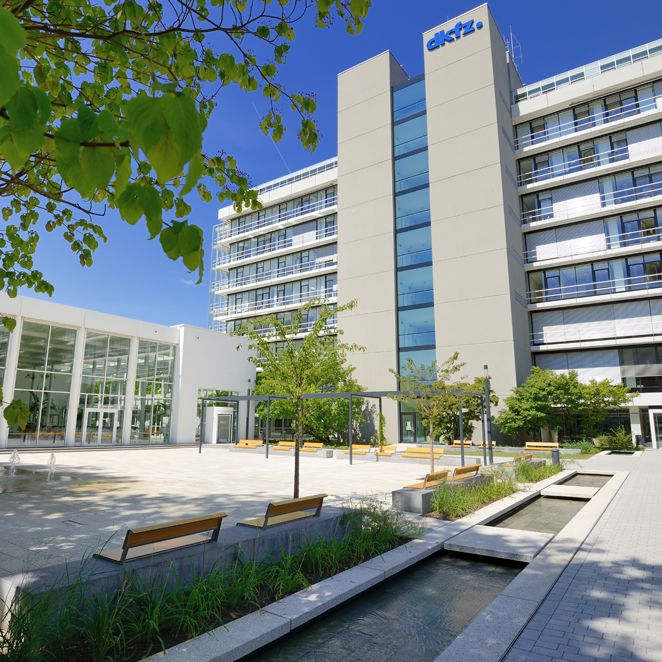Cutting-edge research against cancer: The German Cancer Research Center (DKFZ) combines excellent research with state-of-the-art technology to bring new insights into clinical practice. Using data science and AI, it is developing innovative approaches to combat cancer in a targeted manner.
HIDA's mobility programs enable talented data scientists to work with the DKFZ on pioneering cancer research projects. The goal: to quickly transfer scientific findings into clinical practice and to provide society with sound information about cancer risks and prevention options.
Apply now!

The programs
Get to know the DKFZ with HIDA
The German Cancer Research Center is part of the Helmholtz Association.
Data science talents can conduct research at the Center through the following programs.
The German Cancer Research Center (Deutsches Krebsforschungszentrum, DKFZ) is the leading biomedical research institution in Germany and a pioneer in the use of data science and artificial intelligence (AI) for cancer research. Using state-of-the-art technology, they investigate the development of cancer, develop personalized therapies and search for new active ingredients.
Research priorities:
- Cell and tumor biology
- Functional and structural genome research
- Cancer risk factors and prevention
- Immunology, infection and cancer
- Imaging and radiation oncology
- Development of new cancer therapies
- Digitization and data science in cancer research

The sites
The sites
The sites of the DKFZ:
- Heidelberg (main site)
- Heidelberg
- National Center for Tumor Diseases (NCT)
- Dresden
- National Center for Tumor Diseases (NCT)
- German Consortium for Translational Cancer Research (DKTK) with partner sites in:
- Berlin
- Dresden
- Essen/Düsseldorf
- Frankfurt/Mainz
- Freiburg
- München
- Tübingen
DKFZ expertise in the field of Data Science and AI
The DKFZ has outstanding expertise in data-driven cancer research and uses state-of-the-art AI technologies to analyze complex biological systems. Its interdisciplinary teams of biologists, medical doctors, and data scientists work closely together to develop new approaches for personalized medicine.
Using powerful AI models and big data analytics, they gain deeper insights into the molecular mechanisms of cancer and create innovative solutions to support clinical decision-making.
- AI-supported analysis of histopathology images
- Automated pattern recognition in molecular and clinical data
- Deep learning for personalized therapy recommendations
- Development and application of simulation models for tumor progression
- Multimodal data integration to improve early cancer detection
With a staff of over 3,300, the DKFZ conducts research into how cancer develops, how it can be diagnosed, treated and prevented. In more than 90 departments, researchers are developing targeted agents and personalized therapies.
Notes on application
Notes on application
Helmholtz hosts
Meet some potential hosts at various Helmholtz centers and learn more about their respective data science-based research by clicking on the cards.
Please note: Please contact your potential supervisor in advance by email to suggest and discuss a research project. Only submit your application after this clarification.
If you have any questions, please email: hida@helmholtz.de
Would you like to become a Helmholtz host yourself and are looking for support for your research project? Then please also contact the above email address.
Apply now!
The Hosts at DKFZ
Get to know some of the hosts at the DKFZ and learn more about their respective research based on data science.
Before you contact the potential hosts, please read the application instructions.
Please note: The listed hosts represent only a selection of possible supervisors.
You are also welcome to independently contact other potential hosts at the center and coordinate your participation in the HIDA Mobility Program directly with them.

Klaus Maier-Hein
Medical Image Computing
Contacts

Short summary of your group's research: The Division of Medical Image Computing (MIC) pioneers research in machine learning and information processing in the context of image data analytics. We pursue cutting-edge developments at the core of computer science, with applications in but also beyond medicine. We are particularly interested in techniques for semantic segmentation and object detection as well as in unsupervised learning and probabilistic modelling.
What infrastructure, programs and tools are used in your group?
- Python Software Framework / Pytorch / Phabricator
- A GPU cluster at DKFZ tailored to specific needs, ranging from nodes with RTX 2080ti all the way up to Nvidia’s DGX systems
- The DKFZ has an Openstack cluster in which you can instantiate virtual machines for CPU heavy workloads.
What could a participant of the HIDA Trainee Network learn in your group? How could he or she support you in your group? At MIC we pursue cutting-edge developments at the core of computer science, with applications in but also beyond medicine. We believe a sophisticated research software system and infrastructure are key for methodological excellence, for example to facilitate highly scalable data analysis in a federated setting. In cooperation with numerous (clinical) partners, we work on the direct translation of the latest machine learning advances into relevant clinical applications. Depending on the specific interests of the participant of the HIDA training exchange many interesting and challenging aspects could be addressed. Please find a list of ongoing research project in the department on our website in the "research" section.

Stella Autenrieth
Dendritic Cells in Infection and Cancer
Contacts

Short summary of your group's research: Our research group is interested in elucidating the role of different DC subpopulations, their development and basic function in immune activation by bacterial infections, inflammation, and cancer to improve the basic understanding of DC function in disease but also the potential of DCs as targets for therapeutic intervention. Another focus of our research group is the phenotyping of immune cells using spectral flow cytometry. This allows the detailed characterization of all immune cells in the blood and tissues of patients before and during therapy with the goal of identifying cell populations or biomarkers that can predict therapy response.
What infrastructure, programs and tools are used in your group? The main techniques are spectral flow cytometry and scRNA sequencing. With spectral flow cytometry about 40 proteins that are expressed on or in cells can currently be determined simultaneously at the single cell level. We use tools like OMIQ for flow cytometry data and R for scRNA data analysis.
What could a participant of the HIDA Trainee Network learn in your group? How could he or she support you in your group? We offer insights into single cell analysis of immune cells especially how bacterial infections modulate the dendritic cell development. We hope to get support regarding the molecular mechanisms responsible for the infection-induced impaired dendritic cell development by analyzing our scRNA seq & spectral flow cytometry data.

Oliver Jäkel
Physics in Radiation Oncology
Contacts

Short summary of your group's research: The division of medical physics in radiation oncology at DKFZ comprises multiple research groups, which cover all steps of the radiation treatment chain. We apply machine learning for improving innovative radiotherapy techniques using photons and ion beams. This includes technical developments, improvement of patient-oriented workflows as well as treatment response analyses.
In particular, we focus on the following topics:
1. Image-based patient and motion modeling,
2. Mathematical Methods to optimize physical and biological treatment parameters and dose distributions,
3. Treatment Outcome Analysis & Prediction (Dosiomics & Radiomics),
4. Analysis of molecular and imaging data from preclinical biological studies.
What infrastructure, programs and tools are used in your group?
• Latest generation of radiotherapy treatment machines for image-guided radiotherapy (Ethos, MRLinac, particle therapy)
• Access to data from imaging modalities: MRI, CT, PET
• IT Hardware: Workstations & Servers for AI workflows, OpenStack Computing Cloud
• IT Software: Commercial and Open-Source Treatment Planning and Image Processing Software
• Various series of seminars, lectures and courses
• Close collaboration with data scientists, medical physicists, radiation oncologists, radiologists and biologists
What could a participant of the HIDA Trainee Network learn in your group? How could he or she support you in your group?
Participants of the HIDA Trainee Network will get
• Access to strong interdisciplinary and translational work
• Insights into the latest radiotherapy and imaging developments
• In touch with applications of machine learning to medical (radiotherapy and imaging) data
Candidates could support in data analysis, development of new AI methods and bringing new ideas by translating solutions from a different research field to medical physics.



